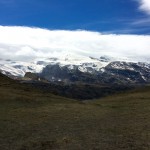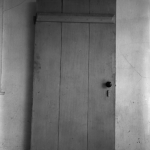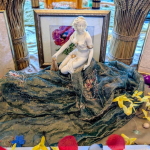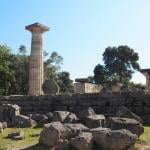Last weekend, Reclaiming LA held our Samhain ritual. Due to some scheduling issues, we hold our ritual the week after Samhain proper, and when I arrived at the venue on Saturday afternoon, I was worried. I worried that the energy would be low, that people would be done with Samhain, that the veil would be thickening again.
There are times when too much of my Witchcraft is taken up with worrying. I worry about whether my perceptions are correct. I worry about whether a download is genuine or a product of my own projection and ego. I worry about balancing priestessing with blogging and work and the kid and fiction writing. I worry that I’ll leave a candle unattended and burn the apartment down. I worry about worrying so much. I worry that I’ll never find my center again.
But those worries often fall away when I’m tending my altar.
Rabbi Jill Hammer and Holly Taya Shere write that “the altar represents the cosmos. The altar is the space that connects the world we live in to the upper and lower worlds, and to the past and future….the altar represents the earth itself: Shekhinah’s body.”
It’s true. The altar is an umbilical cord to the Divine.
* * *
Last Saturday, when all the priestesses had arrived, we set to building the altar. We placed our Hermes and Hekate statues. We set out photos of our beloved dead, leaving room for celebrants to add theirs. We added gifts and offerings: a feather for Hermes, a key for Hekate, candles and branches and pomegranates and miscellaneous pretty things that spoke to our Younger Selves. One priestess had a wonderfully unsettling set of human anatomy figures, and those took prominent spots. I found a deck of tarot cards in the box and chose some appropriate ones. Death, of course; that went in the middle. Then the Moon for Hekate. The Lovers for one of our beloved dead, because in life she was a priestess of Aphrodite.
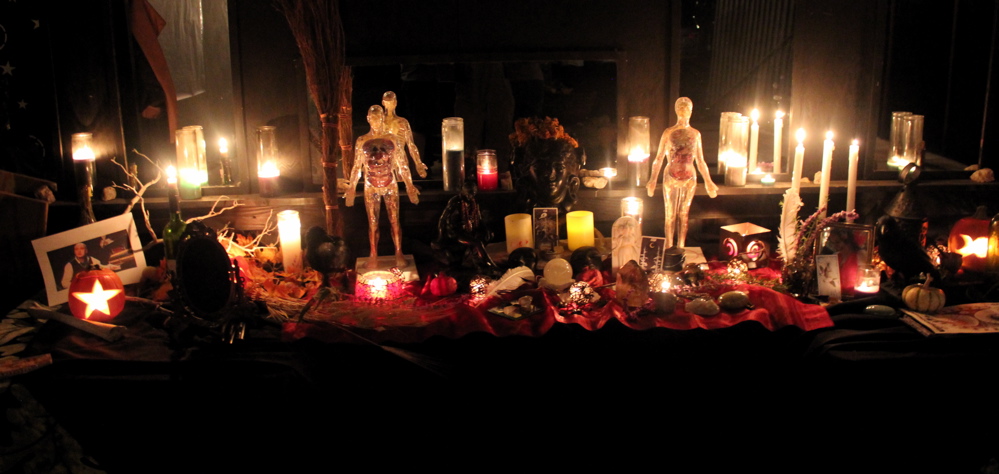
As we worked, one priestess asked if those of us who were going to sing during the trance could rehearse. Of course, we said. We hadn’t done a run-through together yet. So she started and the rest of us joined in:
Set sail, set sail
Over the waves where the spray blows white
Into the night, into the night
Set sail, set sail
Turn your face where the veil grows thin
Beyond the rim, beyond the rim
Set sail, set sail
Follow the twilight to the West
Where you may rest, where you may rest
Set sail, set sail
Over the dark of the sunless sea
You are free, you are free
Set sail, set sail
Four women, singing a spell and tending our altar. Four Witches, our voices lilting in the evening air. When we were finished, the moon rose.
* * *
who is like you
o my people
who bind your stories to your arms
I too
tie my story to the parabolic curves of my body
my physics like an alphabet
you must recover me
from the tar pits of the years**
That night, the ritual went very well. I invoked Hermes and he helped us travel to our ancestors. Another priestess led a Hekate devotional with a harmonium. I drummed solo for the first time (normally I play backup). In trance I met my great-grandmother, who escaped from the pogroms in Poland with her two young children. Family lore has it that she stuffed a rag in my two-year-old grandmother’s mouth to keep her from making noise while they hid from soldiers in the forest. My great-grandmother, who used to hug me as if I’d fly away when I was a little girl, explained to me how fierce and uncompromising motherhood can be.
The ritual was ambitious, but we pulled it off with only a couple of minor hitches. When everything was done and the circle was devoked and everyone went in for the potluck, I felt the same weak relief that any introvert feels after performing. I felt embarrassed about the places where I felt I’d messed up. Deep down, though, I felt gratitude, exhilaration, pride in my calling.
But all that night and for days after, I kept thinking about our time at the altar, when we sang as we placed offerings. The deepest moments of Witchcraft are usually the simplest, when your analytical mind falls away, when you’re lifted by song, when you’re guided by ancient memory and your hands craft something holy. When you feel yourself deeply in service and it doesn’t even matter what exactly you’re serving.
May you recover yourself from the tar pits of the years. May your altar thrum with love.
* “Ritual Tools: The Altar” from Siddur HaKohanot.
** “What Is In the Goddess’s Tefillin?” by Rabbi Jill Hammer, also in Siddur HaKohanot.







